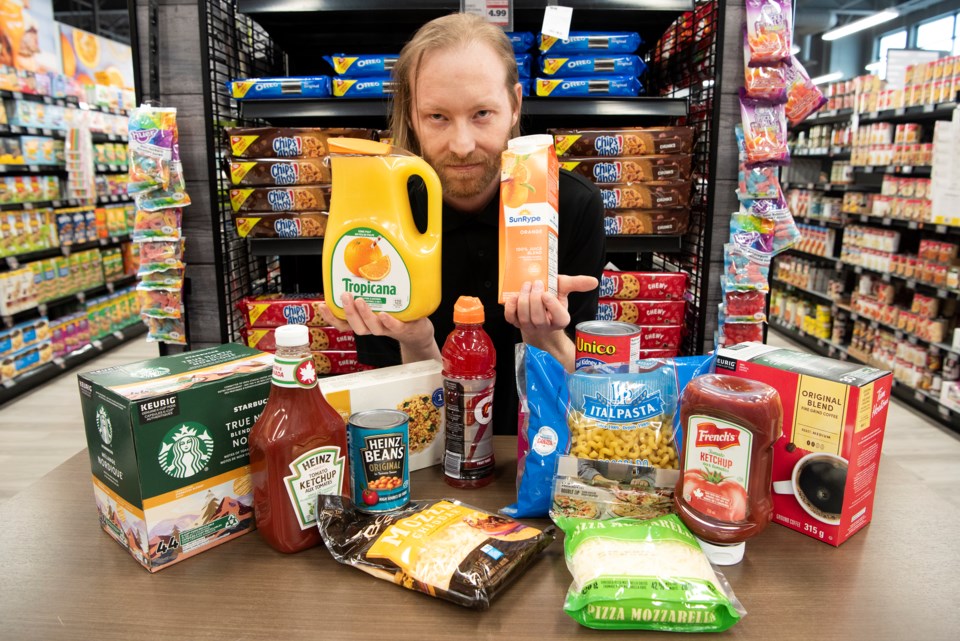Update
On March 6, 2025, President Trump paused tariffs on some, but not all, Canadian goods until April 2. Canadian tariffs on U.S. goods remained in place.
St. Albert residents will soon pay more for coffee, oranges, and many other American goods this month after the first shots of a Canada–U.S. trade war were fired Tuesday (March 4).
U.S. President Donald Trump imposed 25 per cent tariffs on Canadian goods (10 per cent for energy), officially due to fentanyl crossing the border from Canada. (Many commentators have questioned this justification, given than less than one per cent of fentanyl intercepted at the U.S. border comes from Canada; that worked out to about 0.03 pounds last January. Canada has also implemented a $1.3 billion plan to address fentanyl smuggling.)
Trudeau responded with 25 per cent tariffs on $30 billion in American goods, including beer, soap, coffee, oranges, diamonds, refrigerators, and automatic explosive bird-scaring devices. Trudeau and Trump also threatened to impose additional tariffs in the weeks ahead.
These tariffs could have significant impacts on local businesses, and residents should rally to support them by buying local, St. Albert & District Chamber of Commerce chair Angie Hampshire said in a statement.
“We urge all members of our community to stand together, support local businesses, and remain informed as the situation evolves.”
Tariffs at the till
These tariffs will hike prices on many goods in St. Albert stores and make Canadian goods more expensive in the U.S.
Robyn Noel of St. Albert’s Cloud 9 Pajamas said the tariffs would make the clothes she sells to Americans more expensive, and raise the price of the 10 per cent of her stock provided by U.S. companies.
“It’s definitely going to increase pricing for everyone.”
About 40 per cent of the tires sold at the St. Albert Fountain Tire are made by the American company Goodyear, and could be affected by the tariffs, said owner Michael Sands. A 25 per cent tariff would add about $38 to the typical $150 tire.
“It’s significant dollars.”
The tariffs would not affect all American tires equally, as Goodyear and Michelin produce some of their products outside of the U.S., Sands noted. He planned to switch to non-tariffed tires from non-American companies such as Sailun and Kumho where possible to dodge the tariffs.
Noel said she has redoubled her efforts to stock Canadian brands, noting that she had seen a spike in customers asking for Canadian products lately. She recently flagged all Canadian products on her website with little maple leaves — a tactic many area grocery stores have also employed.
“With the exchange rate going up so substantially this year and the tariffs on top of it, goods from the U.S. are going to become really costly.”
Now what?
Now is the time for Canadians to really think about what they want from their relationship with the U.S., said Gitane De Silva, Alberta’s senior representative to the U.S. from 2016–2019 and an expert on Canada–U.S. relationships.
“Do we want to be so captive to one market?”
Canada can offset these tariffs by removing interprovincial trade barriers such as its different trucking standards, De Silva said. This could mean harmonizing regulations or mutual recognition of them, so that a truck inspected in Alberta wouldn’t have to be re-inspected in Saskatchewan.
“The political will is needed to make these changes,” she noted, as they will result in winners and losers.
De Silva said St. Albert residents can help end this trade dispute by talking to their local leaders about how they want to see it resolved.
“Almost every Canadian knows a few Americans,” she added, and we should speak with them about the benefits of trade and how tariffs hurt them.
It’s also important to take a deep breath and think of the big picture, De Silva said.
“Canada and the U.S are neighbours for life, and we will figure this out.”
De Silva will speak to the St. Albert & District Chamber of Commerce on Canada–U.S. relations on March 12. See the events calendar at stalbertchamber.com for details.



